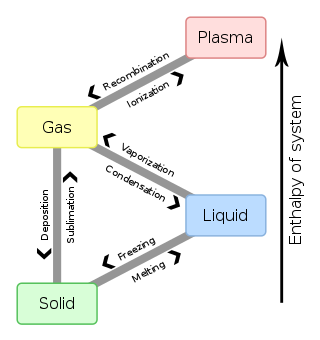Strange matter
Strange matter, or strange quark matter, is quark matter containing strange quarks. In nature, strange matter is hypothesized to occur in the core of neutron stars, or, more speculatively, as isolated droplets that may vary in size from femtometers (strangelets) to kilometers, as in the hypothetical strange stars. At high enough density, strange matter is expected to be color superconducting.
Ordinary matter, also referred to as atomic matter, is composed of atoms, with nearly all matter concentrated in the atomic nuclei. The nuclear matter is a liquid composed of neutrons and protons, and they are themselves composed of up and down quarks. Quark matter is a condensed form of matter composed entirely of quarks. If quark matter contains strange quarks, it is often called strange matter (or strange quark matter), and when quark matter does not contain strange quarks, it is sometimes referred to as non-strange quark matter.
Two meanings of the term "strange matter"
In particle physics and astrophysics, the term is used in two ways, one broader and the other more specific[1][2]
- The broader meaning is simply quark matter that contains three types of quarks: up, down, and strange. In this definition, there is a critical pressure and an associated critical density, and when nuclear matter (made of protons and neutrons) is compressed beyond this density, the protons and neutrons dissociate into quarks, yielding quark matter (probably strange matter).
- The narrower meaning is that quark matter is more stable than nuclear matter, i.e. that the true ground state of matter is quark matter. The idea that this could happen is the "strange matter hypothesis" of Bodmer[3] and Witten.[4] In this definition, the critical pressure is zero. The nuclei that we see in the matter around us, which are droplets of nuclear matter, are actually metastable, and given enough time (or the right external stimulus) would decay into droplets of strange matter, i.e. strangelets.
Strange matter that is only stable at high pressure
Under the broader definition, strange matter might occur inside neutron stars, if the pressure at their core is high enough (i.e. above the critical pressure). At the sort of densities and high pressures we expect in the center of a neutron star, the quark matter would probably be strange matter. It could conceivably be non-strange quark matter, if the effective mass of the strange quark were too high. Charm quarks and heavier quarks would only occur at much higher densities.
A neutron star with a quark matter core is often[1][2] called a hybrid star. However, it is hard to know whether hybrid stars really exist in nature because physicists currently have little idea of the likely value of the critical pressure or density. It seems plausible that the transition to quark matter will already have occurred when the separation between the nucleons becomes much smaller than their size, so the critical density must be less than about 100 times nuclear saturation density. But a more precise estimate is not yet available, because the strong interaction that governs the behavior of quarks is mathematically intractable, and numerical calculations using lattice QCD are currently blocked by the fermion sign problem.
One major area of activity in neutron star physics is the attempt to find observable signatures by which we could tell, from earth based observations of neutron stars, whether they have quark matter (probably strange matter) in their core.
Strange matter that is stable at zero pressure
If the "strange matter hypothesis" is true then nuclear matter is metastable against decaying into strange matter. The lifetime for spontaneous decay is very long, so we do not see this decay process happening around us.[4] However, under this hypothesis there should be strange matter in the universe:
- Quark stars (often called "strange stars") consist of quark matter from their core to their surface. They would be several kilometers across, and may have a very thin crust of nuclear matter.[2]
- Strangelets are small pieces of strange matter, perhaps as small as nuclei. They would be produced when strange stars are formed or collide, or when a nucleus decays.[1]
See also
- Exotic matter – Any kind of non-baryonic matter
- Negative matter
- Quark matter
- Quark star – Compact exotic star which forms matter consisting mostly of quarks
- Strangeness and quark-gluon plasma
- Strangelet – Type of hypothetical particle
- Quark – Elementary particle
- QCD matter – Theorized phases of matter whose degrees of freedom include quarks and gluons
References
- Madsen, Jes (1999). "Physics and astrophysics of strange quark matter". Hadrons in Dense Matter and Hadrosynthesis. Lecture Notes in Physics. 516. pp. 162–203. arXiv:astro-ph/9809032. doi:10.1007/BFb0107314. ISBN 978-3-540-65209-0.
- Weber, F. (2005). "Strange quark matter and compact stars". Progress in Particle and Nuclear Physics. 54 (1): 193–288. arXiv:astro-ph/0407155. Bibcode:2005PrPNP..54..193W. doi:10.1016/j.ppnp.2004.07.001..
- Bodmer, A. R. (1971). "Collapsed Nuclei". Physical Review D. 4 (6): 1601–1606. Bibcode:1971PhRvD...4.1601B. doi:10.1103/PhysRevD.4.1601.
- Witten, Edward (1984). "Cosmic separation of phases". Physical Review D. 30 (2): 272–285. Bibcode:1984PhRvD..30..272W. doi:10.1103/PhysRevD.30.272.
